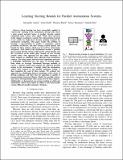Learning Steering Bounds for Parallel Autonomous Systems
Author(s)
Amini, Alexander A; Paull, Liam; Balch, Thomas M; Karaman, Sertac; Rus, Daniela L
DownloadAuthor's final manuscript (2.894Mb)
OPEN_ACCESS_POLICY
Open Access Policy
Creative Commons Attribution-Noncommercial-Share Alike
Terms of use
Metadata
Show full item recordAbstract
Deep learning has been successfully applied to “end-to-end” learning of the autonomous driving task, where a deep neural network learns to predict steering control commands from camera data input. While these previous works support reactionary control, the representation learned is not usable for higher-level decision making required for autonomous navigation. This paper tackles the problem of learning a representation to predict a continuous control probability distribution, and thus steering control options and bounds for those options, which can be used for autonomous navigation. Each mode of the distribution encodes a possible macro-action that the system could execute at that instant, and the covariances of the modes place bounds on safe steering control values. Our approach has the added advantage of being trained on unlabeled data collected from inexpensive cameras. The deep neural network based algorithm generates a probability distribution over the space of steering angles, from which we leverage Variational Bayesian methods to extract a mixture model and compute the different possible actions in the environment. A bound, which the autonomous vehicle must respect in our parallel autonomy setting, is then computed for each of these actions. We evaluate our approach on a challenging dataset containing a wide variety of driving conditions, and show that our algorithm is capable of parameterizing Gaussian Mixture Models for possible actions, and extract steering bounds with a mean error of only 2 degrees. Additionally, we demonstrate our system working on a full scale autonomous vehicle and evaluate its ability to successful handle various different parallel autonomy situations.
Date issued
2018-05Department
Massachusetts Institute of Technology. Computer Science and Artificial Intelligence Laboratory; Massachusetts Institute of Technology. Department of Aeronautics and Astronautics; Massachusetts Institute of Technology. Department of Electrical Engineering and Computer Science; Massachusetts Institute of Technology. Department of Mathematics; Massachusetts Institute of Technology. Department of Mechanical EngineeringJournal
2018 IEEE International Conference Robotics and Automation (ICRA)
Publisher
Institute of Electrical and Electronics Engineers (IEEE)
Citation
Amini, Alexander, Liam Paull, Thomas Balch, Sertac Karaman and Daniela Rus. "Learning Steering Bounds for Parallel Autonomous Systems." 2018 IEEE International Conference Robotics and Automation (ICRA), 21-26 May 2018, Brisbane, Australia.
Version: Author's final manuscript